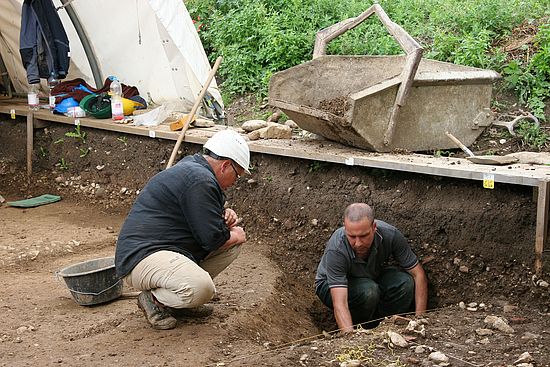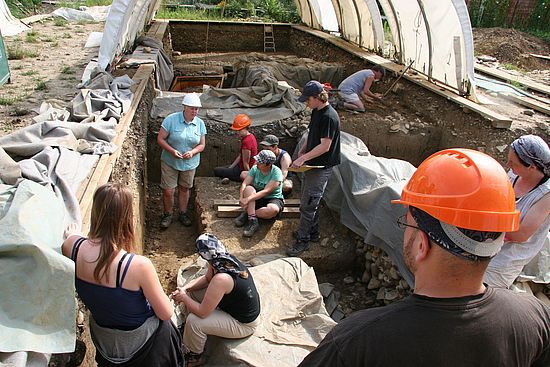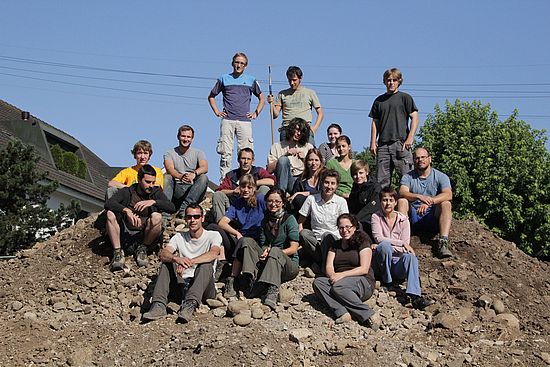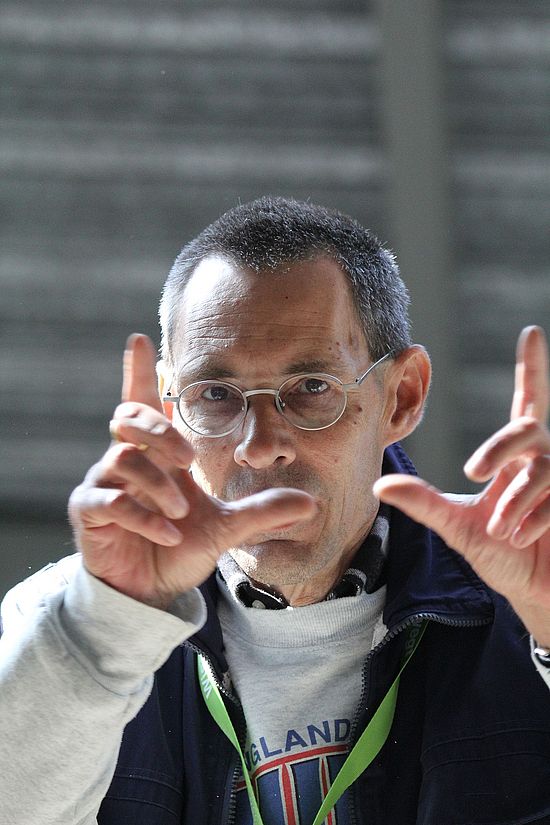Teaching and research excavation Kaiseraugst-Auf der Wacht 2011-2013
The six-week teaching and research excavations in the Kaiseraugst-Wacht corridor in 2011, 2012 and 2013 were carried out in close cooperation with the Kaiseraugst Excavations Department of the Aargau Cantonal Archaeology Department.
The "Auf der Wacht" field lies in the area of the Imperial Period residential and craftsmen's quarters of the colony town of Augusta Raurica or the suburbium in the southwestern forefield of the Late Antique Castrum Rauracense.
The excavations, which lasted several years, have yielded important information on the structural development, commercial use, and architectural design of the strip houses, among other things. Among the more spectacular discoveries were a sod well over 14 meters deep, a basement with niches and plastered walls, and a cellar filled with fire debris.
In the course of the excavations, it was also possible to prove that individual quarters had already been abandoned in the early 3rd century AD and were no longer inhabited. Some time later, new (?) owners installed pottery kilns in the half-ruined buildings. In these, plates, dishes and drinking cups were produced.
In the next few years, the Vindonissa Professorship will - within the framework of interdisciplinary courses or seminar and practical work - primarily study the rich find material from the sod well, which is about 14m deep, and from the various shafts, some of which are filled with latrine sediments, as well as - with specific questions - individual groups of finds (e. g. The excavations will also be used to analyze and evaluate individual groups of finds (e.g. glass, "false coin molds"; animal bones, archaeobotanical macroremains) as well as some of the micromorphological sediment samples.
Depending on the possibility, the excavations will be continued in the foreseeable future.
Literature:
- L. Berger et al, Guide to Augusta Raurica (7th edition of the guide to Augusta Raurica founded by R. Laur-Belart, Basel 2012).
- C. Grezet (with contributions by S. Ammann, S. Cox, L. Grolimund, S. Wyss and with the collaboration of Markus Peter and Clara Saner), Ausgraungen in Kaiseraugst im Jahr 2011. Jahresbericht aus Augst und Kaiseraugst 33, 2012, 55-115. [PDF (3.2 MB)]
- C. Grezet (with contributions by S. Cox, L. Grolimund, M. Peter, A. Pignolet, and F. von Wyl), Excavations at Kaiseraugst in 2012. Annual Reports from Augst and Kaiseraugst 34, 2013, 41-91, esp. 43-77. [PDF (4.5 MB)]
- C. Grezet (with contributions by M. Allemann, S. Cox, A. R. Furger, L. Grolimund, and T. Nerini). Excavations at Kaiseraugst in 2013. Jber. Augst and Kaiseraugst 35, 2014, 55-106. [PDF (14.5 MB)]
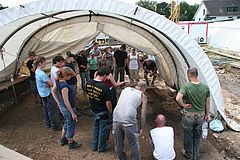

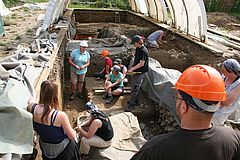
For six weeks, 18 archaeology students from the University of Basel help uncover traces of the Roman past on an excavation in Kaiseraugst. In the process, they learn about essential areas of archaeological fieldwork and can already gain practical experience for their future profession.
The large-scale archaeological excavation is located in the middle of a quiet residential area in Kaiseraugst, where traces and remains of the Roman settlement in the lower town of Augusta Raurica are currently being unearthed. Where Roman craftsmen and tradesmen lived and worked over 2000 years ago, budding archaeologists are now digging for remains of that time. From rough picks and shovels to finer working methods with brushes to making scale drawings, students also learn how to interpret and classify the finds. They benefit from the know-how and experience of the team of archaeologists from the canton of Aargau and the archaeologists from the University of Basel, who are leading the excavation in collaboration. In a workshop, the team of restorers from the Roman city also showed the students the procedure for the conservation of metal and the production of replicas.
The work on the excavation is very diverse and never gets boring, says master's student Tina Lander, who is already helping out on the excavation for the second time. She is working with three other students to examine a pottery kiln inside a house. The house was probably abandoned by its inhabitants as early as the 3rd century and subsequently used as a workshop.
False coins and a ton ofpottery
The archaeologists kept coming across unexpected things during their work. For example, an underground room puzzles the specialists. The almost two meter high walls of the room are plastered with lime mortar and have niches where presumably candles were placed. One possibility is a cultic use of the room, according to Cédric Grezet of the Aargau Cantonal Archaeology Department. Around the middle of the 3rd century AD, however, the room was abandoned and filled with building rubble.
In an uncovered draw well, archaeologists found more than a ton of pottery: 100,000 fragments of drinking cups, bowls, plates and jugs. Among them were also 50 casting molds for making counterfeit money. This was an "unofficial imitation" of real coins, since legal money was often scarce in the Roman Empire and this "emergency money" was tolerated by the administration. The specialists recognized the counterfeit coins by their lack of minting. Now the coins are passed on to the numismatist (coin specialist) for more precise identification.
The interpretation of finds from the everyday life of people, which no one has held in their hands for over 1800 years, requires great expertise. For example, in the case of an uncovered shaft, the experts suspect that it could be a so-called ice cellar. These were filled with ice and snow in winter and served as refrigerators for food such as oysters and milk in summer.
The Lower Town is a craftsmen's quarter from the period between the late 1st and late 3rd centuries A.D. Investigations of the Roman settlements will continue until 2015, after which the site will be built over. Cédric Grezet and the Aaargau cantonal archaeologist Dr. Elisabeth Bleuer are responsible for the excavations at Kaiseraugst. During the six-week teaching excavation, Prof. Dr. Peter-Andrew Schwarz, holder of the Vindonissa Professorship for Archaeology of the Roman Provinces at the University of Basel, is co-directing the excavation.
Feedback from the students on the 2012 excavation campaign [PDF (138 KB)]
Preliminary report on the 2012 excavation campaign (CG Jber AK) [PDF (4.5 MB)]
Pictures of theexcavation
More pictures of the excavation can be found on the Facebook page of the University of Basel >
Press and News
Press review of the teaching and research excavation Kaiseraugst-Wacht 2012 [PDF (4.6 MB)]
Broadcast on DRS 2 from 13.07.2012
Report on Telebasel from 14.07.2012 (from minute 9)
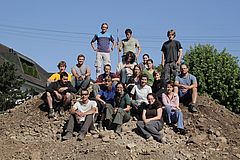
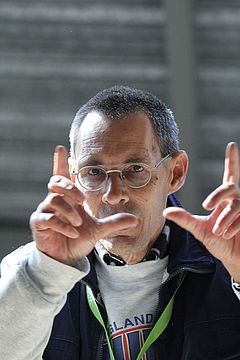
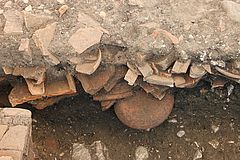
Report on the 2011 excavation campaign (CG & PAS) = Article in Augusta Raurica 2011_2[PDF (5.6 MB)]
Preliminary report on the 2011 excavation campaign (CG Jber AK) [PDF (3.2 MB)]
Feedbacks of the students on the excavation campaign 2011 [PDF (81 KB)]
Quick Links


